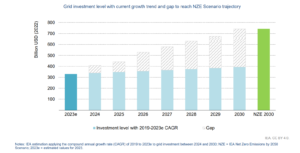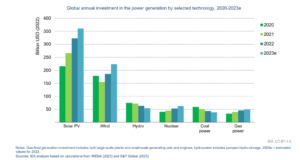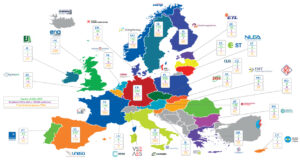Written by Ypatios Moysiadis, Managing Partner at Wattcrop.
In the face of escalating climate change and the urgent need for sustainable energy solutions, Europe finds itself at a critical juncture. The transition toward a greener, more sustainable future hinges on the robustness of its energy infrastructure. Current figures from various European nations underscore the necessity of substantial investments in high-voltage grid infrastructure and the enhancement of cross-border system integration. In this extensive exploration, we delve deep into the landscape of current investments, the imperative of grid reinforcement, and the pivotal role these enhancements play in facilitating the green transition, integrating more renewable energy systems, and fostering the production of green hydrogen.
1.Current Investments: A Closer Look
Recent data reveals that European nations have made substantial investments in their energy infrastructure, with a significant portion directed towards renewable energy sources. For instance, Germany has invested approximately €50 billion in renewable energy projects in the past decade, making it one of the leading countries in the renewable energy sector. Denmark, with a keen focus on wind energy, has allocated nearly €3 billion to offshore wind projects, ensuring a steady increase in their renewable energy capacity.
Despite these investments, a substantial gap remains in terms of high voltage grid infrastructure. According to the European Network of Transmission System Operators for Electricity (ENTSO-E), an estimated €150 billion in investment is required by 2030 to strengthen and expand the high voltage grid infrastructure across Europe.
2.The Imperative of Grid Reinforcement
 Investment in high voltage grid infrastructure is pivotal for several reasons, especially in the context of the green transition. According to IEA there is a growing gap in grid investment levels which will surpass $300 billion by 2030 if we are to reach a Net Zero scenario by 2050. This gap can be partly addressed if private investment is allowed to accelerate grid infrastructure projects through the necessary reform on the regulatory framework.
Investment in high voltage grid infrastructure is pivotal for several reasons, especially in the context of the green transition. According to IEA there is a growing gap in grid investment levels which will surpass $300 billion by 2030 if we are to reach a Net Zero scenario by 2050. This gap can be partly addressed if private investment is allowed to accelerate grid infrastructure projects through the necessary reform on the regulatory framework.
Facilitating Renewable Energy Integration: High voltage grids act as the backbone for renewable energy integration. These grids enable the seamless transmission of energy from wind farms, solar parks, and other renewable sources to urban centers. Currently, an estimated 30% of Europe’s electricity comes from renewable sources, a figure that is expected to rise significantly with increased grid integration.
Enabling the Rise of Green Hydrogen: Green hydrogen production, a key component of Europe’s decarbonization strategy, requires significant amounts of renewable electricity. By investing in high voltage grid infrastructure, surplus renewable energy can be efficiently transported to hydrogen production facilities. Estimates suggest that Europe could produce up to 1 million tons of green hydrogen by 2030 with the right grid infrastructure in place.
Supporting Energy Storage Solutions: High voltage grids facilitate the integration of energy storage solutions such as large-scale batteries and pumped hydro storage. These technologies are instrumental in balancing energy supply and demand, especially in the presence of intermittent renewable sources like solar and wind. Investments in grid infrastructure can further enhance the efficiency of these storage systems, ensuring a stable energy supply even during periods of high demand.
3.Integrating More Renewable Energy Systems
 The integration of diverse renewable energy systems is pivotal to achieving Europe’s renewable energy targets. Solar photovoltaic (PV) installations have seen significant growth, with over 140 GW of installed capacity in Europe. Wind energy, both onshore and offshore, has also experienced rapid expansion, with offshore wind capacity expected to reach 78 GW by 2030, a threefold increase from current levels. As we can see in the graph by IEA Solar PV and wind remains the leaders in Global Annual Investment for Power Generation between 2020 and 2023. It is highly expected that this trend will remain unchanged for the foreseeable future.
The integration of diverse renewable energy systems is pivotal to achieving Europe’s renewable energy targets. Solar photovoltaic (PV) installations have seen significant growth, with over 140 GW of installed capacity in Europe. Wind energy, both onshore and offshore, has also experienced rapid expansion, with offshore wind capacity expected to reach 78 GW by 2030, a threefold increase from current levels. As we can see in the graph by IEA Solar PV and wind remains the leaders in Global Annual Investment for Power Generation between 2020 and 2023. It is highly expected that this trend will remain unchanged for the foreseeable future.
Furthermore, the integration of innovative technologies such as tidal and geothermal energy presents new opportunities. Tidal energy projects in the Bay of Biscay, the Pentland Firth, and other locations have the potential to provide consistent, predictable energy. Geothermal projects in countries like Iceland and Italy already contribute significantly to their energy mix.
4.Fostering the Production of Green Hydrogen
Green hydrogen, produced by electrolyzing water using renewable electricity, holds immense promise as a clean energy carrier. Its applications in sectors like transportation (very specific applications, where batteries cannot currently compete), industry (especially in Steel, Fertilisers and Chemical Industries), long-term storage (maybe in a liquified converted form) and high-temperature heating can significantly reduce greenhouse gas emissions. However, the widespread adoption of green hydrogen hinges on the availability of low-cost, renewable electricity. High voltage grid infrastructure is indispensable for transporting surplus renewable energy to hydrogen production sites.
Investing in grid infrastructure tailored for green hydrogen production zones not only supports the growth of this nascent industry but also creates a new avenue for renewable energy utilization, bolstering the overall sustainability of the energy sector. Current estimates suggest that the cost of green hydrogen could decrease by 30% with sufficient investments in grid infrastructure, making it competitive with fossil fuel-based hydrogen.
5.A Unified Vision for Europe’s Energy Future
 Looking at the European DSO map, even a non-expert can grasp the complexities of navigating the current regulatory framework. However, in light of the pressing need to strengthen high voltage grid infrastructure and enhance cross-border system integration, a unified vision for Europe’s energy future is paramount. Current data shows that nations with advanced grid systems experience higher levels of energy security, economic growth, and environmental sustainability. Collaborative efforts between governments, regulatory bodies, and industry stakeholders are essential to create a comprehensive strategy that addresses the challenges and maximizes the opportunities presented by the green transition.
Looking at the European DSO map, even a non-expert can grasp the complexities of navigating the current regulatory framework. However, in light of the pressing need to strengthen high voltage grid infrastructure and enhance cross-border system integration, a unified vision for Europe’s energy future is paramount. Current data shows that nations with advanced grid systems experience higher levels of energy security, economic growth, and environmental sustainability. Collaborative efforts between governments, regulatory bodies, and industry stakeholders are essential to create a comprehensive strategy that addresses the challenges and maximizes the opportunities presented by the green transition.
Paving the Way for a Sustainable Tomorrow
The imperative to invest in high voltage grid infrastructure and enhance cross-border system integration is not just a matter of energy modernization; it is an investment in Europe’s sustainable future. The figures clearly indicate that nations with robust grid systems experience higher economic growth, increased energy security, and reduced greenhouse gas emissions. As Europe accelerates its journey toward a low-carbon future, strategic investments in grid infrastructure will pave the way for a seamless transition.
By fostering the integration of diverse renewable energy sources, supporting the production of green hydrogen, and embracing innovative technologies, Europe can lead the way in the global transition to sustainable energy. It is a shared responsibility to transform these investments into tangible realities, ensuring that future generations inherit a planet powered by clean, renewable energy. The time for action is now, and by working together, Europe can pioneer a path toward a sustainable tomorrow, powered by the limitless potential of green energy.
